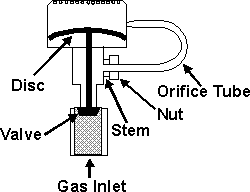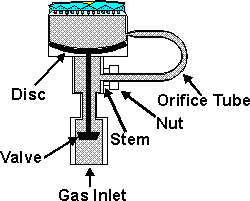Dave's Place
Teddington Burner
You should read the section on gas safety before attempting any repairs.

Like its predecessor the Klixon valve, the Teddington burner uses a bi-metallic disc to control the safety mechanism. The Teddington burner "improved" on the Klixon by being an all-in-one device. It was the safety, the burner, and the orifice. The Teddington burner has not been used on gas refrigerators since the early 70's, but is still available.
The burner head of the Teddington burner contains a bi-metallic disc that is concave at normal temperatures. In this position, the valve connected to the disc is held in a closed position, preventing the flow of gas. (Above) When lighting the burner, an external lighting flame is applied to the burner body. When sufficient heat is transferred to the bi-metallic disc from the lighting flame, the disc snaps into a convex position, with an audible click, and opens the valve allowing the flow of propane through the orifice tube to the burner. (Below) The lighting flame then ignites the burner flame. Heat from the burner flame on the burner body keeps the valve open.
If the burner flame goes out, the burner body cools and therefore the bi-metallic disc cools, causing it to snap into the concave position, with an audible click, and close the valve. (Above).

Troubleshooting
If the bi-metallic disc fails to snap open or close, replace the burner. There is more than one
size Teddington burner, so be sure to get the correct one.
Probably the most common and frustrating problem with the Teddington burner is a dirty or clogged orifice tube. Like any orifice it can pick up oil and debris, causing it not to produce a correct flame. Unlike other orifices, it's nearly impossible to clean. The only thing you can do is remove the orifice tube from the valve body and soak it in alcohol or paint thinner. CAUTION: Use a small backing wrench on the threaded stem connected to the valve body when loosening the nut for the orifice tube. If you don't, it's almost a guarantee that you'll break the stem off when attempting to break the nut loose. After soaking the tube for several hours, blow high air pressure through it. Hopefully this will do the trick. Reassemble and test. If, after repeated attempts at cleaning the orifice tube, you still fail to get a good flame, replace the burner. UPDATE: The sizes of the Teddington burners common to RV refrigerators are no longer available.
RV Refrigerator Home
This RV refridgerator information was originally located on rvmobile.comRV Mobile Inc. 11715 HWY 99, Everett, WA 98204
The owner of RV Mobile Inc. apparently suffered a heart attack and the original website was shut down.
It has been reposted here to preserve this wealth of information RV refridgerator information.